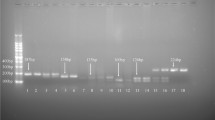Abstract
Objective
The aim of this investigation was to assess the association between single nucleotide polymorphisms (SNPs) in HLA-DRB1 and the risk of developing cervical cancer. Our study focused on the second exon of the HLA-DRB1 alleles, which have most of the SNP sites on HLA-DRB1.
Methods
We examined 30 cervical cancer patients and 66 control patients using the sequence-based typing polymerase chain reaction technique (PCR-SBT) to type 55 single nucleotide polymorphisms (SNPs) and haplotypes in the second exon of HLA-DRB1. The Chi-square test and the Bonferroni correction method were utilized for the statistical analysis of the data. An association between the alleles and cervical cancer was examined by the linkage disequilibrium test and the odds ratio (OR).
Results
Compared with the control group, among the 55 SNPs we studied in the second exon of HLA-DRB1, 4 showed an evident association with cervical cancer. Rs17880292 (P = 0.033, OR = 0.322) and rs1059586 (P = 0.029, OR = 2.657) had positive significance for the risk of developing cervical cancer, while rs17879702 (P = 0.016, OR = 0.222) and rs17882525 (P = 0.025, OR = 0.128) were negative. The diff erence in frequency of the 5582A-5592A-5667T haplotype between cervical cancer patients and the controls was significant (P = 0.043, OR = 2.735).
Conclusion
The rs17880292 G/A genotype and the rs1059586 A/A genotype could be linked to an increased risk of cervical cancer. Rs17879702 and rs17882525 might be haplotype-tag SNPs (htSNPs) or belong to some other haplotypes, which might exert a protective effect against cervical cancer in combination. The 582A-5592A-5667T haplotype was shown to be a marker for susceptibility to cervical carcinogenesis.
Similar content being viewed by others
References
Parkin DM, Pisani P, Ferlay J. Estimates of the worldwide incidence of 25 major cancers in 1990. Int J Cancer 1999; 80: 827–841.
Parkin DM, Bray F, Ferlay J, et al. Estimating the world cancer burden: Globocan 2000. Int J Cancer 2001; 94: 153–156.
Muñoz N, Bosch FX, Castellsagué X, et al. Against which human papillomavirus types shall we vaccinate and screen? The international perspective. Int J Cancer 2004; 111: 278–285.
Kohaar I, Thakur N, Salhan S. TNFα-308G/A polymorphism as a risk factor for HPV associated cervical cancer in the Indian population. Cellular Oncology 2007; 29: 249–256.
Taillon-Miller P, Bauer-Sardina I, Saccone NL, et al. Juxtaposed regions of extensive and minimal linkage disequilibrium in human Xq25 and Xq28. Nat Genet 2000; 25: 324–328.
Madeleine MM, Brumback B, Cushing-Haugen KL, et al. Human leukocyte antigen class II and cervical cancer risk: a population-based study. J Infect Dis 2002; 186: 1565–1574.
Davidson EJ, Davidson JA, Sterling JC, et al. Association between human leukocyte antigen polymorphism and human papillomavirus 16-positive vulval intraepithelial neoplasia in British women. Cancer Res 2003; 63: 400–403.
Allen M, Kalantari M, Ylitalo N, et al. HLADQ-DR haplotype and susceptibility to cervical carcinoma: indications of increased risk for development of cervical carcinoma in individuals infected with HPV 18. Tissue Antigens 1996; 48: 32–37.
Lin P, Koutsky LA, Critchlow CW, et al. HLA class II DR-DQ and increased risk of cervical cancer among Senegalese women. Cancer Epidemiol Biomarkers Prev 2001; 10: 1037–1045.
Wu Y, Liu B, Lin W, et al. Human leukocyte antigen class II alleles and risk of cervical cancer in China. Hum Immunol 2007; 68: 192–200.
Beskow AH, Josefsson AM, Gyllensten UB. HLA class II alleles associated with infection by HPV16 in cervical cancer in situ. Int J Cancer 2001; 93: 817–22.
Wu Y, Chen Y, Li L, et al. Polymorphic amino acids at codons 9 and 37 of HLADQB1 alleles may confer susceptibility to cervical cancer among Chinese women. Int J Cancer 2006; 118: 3006–3011.
Dehaghani AS, Amirzargar A, Farjadian S, et al. HLADQBl alleles and susceptibility to cervical squamous cell carcinoma in Southern Iranian patients. Pathol Oncol Res 2002; 8: 58–61.
Apple RJ, Erlich HA, Klitz W, et al. HLADR-DQ associations with cervical carcinoma show papillomavirus-type specificity. Nat Genet 1994; 6: 157–162.
Sastre-Garau X, Loste MN, Vincent-Salomon A, et al. Decreased frequency of HLA-DRB1 13 alleles in Frenchwomen with HPV-positive carcinoma of the cervix. Int J Cancer 1996; 69: 159–164.
Wank R, Thomssen C. High risk of squamous cell carcinoma of the cervix for women with HLA-DQw3. Nature 1991; 352: 723–725.
Silva B, Vargas-Alarcon G, Zuniga-Ramos J, et al. Genetic features of Mexican women predisposing to cancer of the uterine cervix. Hum Pathol 1999; 30: 626–628.
Wang SS, Wheeler CM, Hildesheim A, et al. Human leukocyte antigen class I and II alleles and risk of cervical neoplasia: results from a population-based study in Costa Rica. J Infect Dis 2001; 184: 1310–1314.
Hughes AL, Yeager M. Natural selection at major histocompatibility complex loci of vertebrates. Annu Rev Genet 1998; 32: 415–435.
Hadden JW. Immunotoxicology and Immunopharmacology. Adv Exp Med Biol 1991; 288: 1–11.
Marincola FM, Shamamian P, Rivoltini L, et al. HLA associations in the antitumor response against malignant melanoma. J Immunother Emphasis Tumor Immunol 1995; 18: 242–252.
Horne BD, Camp NJ. Principal component analysis for selection of optimal SNP-sets that capture intragenic genetic variation. Genet Epidemiol 2004; 26: 11–21.
Johnson GC, Esposito L, Barratt BJ, et al. Haplotype tagging for the identification of common disease genes. Nat Genet 2001; 29: 233–237.
Zhang K, Deng M, Chen T, et al. A dynamic programming algorithm for haplotype block partitioning. Proc Natl Acad Sci USA 2002; 99: 7335–7339.
Zhang K, Calabrese P, Nordborg M, et al. Haplotype block structure and its applications to association studies: power and study designs. Am J Hum Genet 2002; 71: 1386–1394.
Author information
Authors and Affiliations
Corresponding author
About this article
Cite this article
Li, Yy., Yang, Gf., Jia, Yj. et al. Genetic polymorphism in the second exon of HLA-DRB1 in cervical cancer. Clin. Oncol. Cancer Res. 7, 27–32 (2010). https://doi.org/10.1007/s11805-010-0027-9
Received:
Accepted:
Published:
Issue Date:
DOI: https://doi.org/10.1007/s11805-010-0027-9




